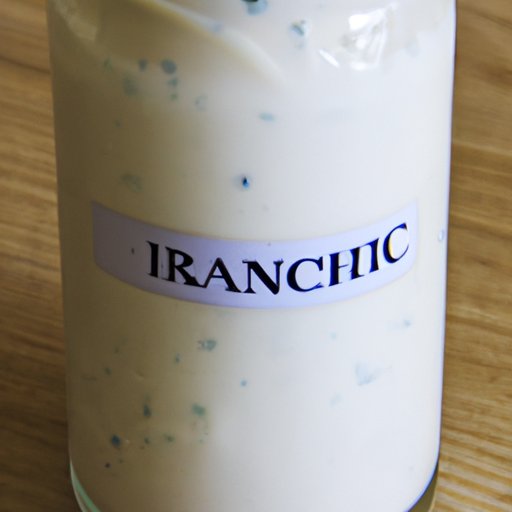Introduction
Ranch dressing has become an American staple in many households. Originally created at Hidden Valley Ranch in California, it has now become a beloved addition to not only salads but also chicken wings, pizza, sandwiches, and more. In this article, we will delve into the step-by-step instructions on how to make homemade ranch dressing, offer variations, discuss nutritional benefits and drawbacks, and share tips for using and storing it.
Step-by-step recipe guide for making homemade ranch dressing
Here are the ingredients you will need to make delicious homemade ranch dressing:
- 1 cup sour cream
- 1/2 cup buttermilk
- 1/4 cup mayonnaise
- 1 teaspoon garlic powder
- 1 teaspoon onion powder
- 1 tablespoon chopped fresh parsley
- 1 tablespoon chopped fresh chives
- 1 teaspoon salt
- 1/2 teaspoon black pepper
Instructions:
- In a medium bowl, whisk together the sour cream, buttermilk, and mayonnaise.
- Add garlic powder, onion powder, parsley, chives, salt, and pepper, and mix well until all is combined.
- Cover the bowl with plastic wrap and chill for at least 30 minutes, but preferably overnight.
- Before serving, stir the mixture well, adding more buttermilk or salt and pepper if needed.
Tips: For a thicker and tangier ranch dressing, use more sour cream. For a more liquid and milder dressing, use more buttermilk. Add more or less garlic powder, onion powder, or herbs to taste.
Step-by-step photos may help guide you through the process of making homemade ranch dressing even easier.
The history and culture of ranch dressing
Ranch dressing was invented by Steve Henson, a plumber from Nebraska. He and his wife, Gayle, moved to California and bought a ranch, which eventually led to the creation of the famous Hidden Valley Ranch dressing in the 1950s. It quickly became popular among guests and was soon bottled and sold in stores.
Nowadays, ranch dressing is a staple in America. The dressing can usually be found at every grocery store, on nearly every restaurant’s menu, and in millions of households across the country. It has also become a cultural touchstone, appearing in jokes and even making appearances in movies.
Fun fact: Ranch dressing is the number one salad dressing in America, with more than 40% of people listing it as their favorite.
Variations of ranch dressing
While classic ranch dressing is a fan favorite, there are a number of variations that can add a creative twist to your salad or meal.
- Avocado Ranch: Add 1 ripe avocado to the mix and blend until smooth.
- Spicy Ranch: Add 1 to 2 teaspoons of hot sauce or chili powder.
- Buttermilk Ranch: Make the recipe as above but use all buttermilk and no sour cream.
Tips: Adding more garlic or onion powder, substituting herbs, or playing with different spices can create a new twist on traditional ranch. Additionally, experimenting with non-dairy options like silken tofu or vegan mayonnaise can provide nutrition-specific alternatives.
Nutritional benefits and drawbacks of ranch dressing
One tablespoon of classic ranch dressing has approximately 75 calories, 7 grams of fat, and 2 grams of carbohydrates. While this doesn’t seem like an enormous amount, the fat is often saturated with partially-hydrogenated oils which can negatively impact health.
To make ranch dressing healthier, you can use low-fat dairy products, substitute Greek yogurt or sour cream for the mayonnaise, and reduce the amount of salt used. Additionally, portion control and moderation are key to avoid overindulging in this delicious dressing.
Using ranch dressing in different ways
While ranch may be most commonly used on salads, that doesn’t mean that’s all it’s good for. There are many other ways to enjoy this dressing. It can make a great dip for raw veggies, a marinade for chicken, or a sauce for potato wedges, burgers, and sandwiches.
Tips: Try pairing ranch dressing with food complements from other cultures like sushi, nachos, or fried foods. Additionally, trying out different craft recipes with ranch dressing (like those mentioned above) can transform it into new and exciting dishes.
Alternatives to traditional ranch dressing
For those looking for a specific nutrition breakdown, there are a variety of alternatives to traditional ranch dressing. Here are some options:
- Vegan Ranch Dressing: This recipe uses a blend of cashews, almond milk, and lemon juice instead of any dairy.
- Ketogenic Ranch Dressing: This creamy blend uses avocado and MCT oil instead of mayonnaise to create the keto version of ranch.
- Greek Yogurt Ranch Dressing: This variation uses Greek yogurt instead of mayo, making it a nutritious and protein-dense option.
Tips: Experimenting with different types of ingredients, textures, and consistencies can create alternative flavors and variations of ranch that you can make for your specific dietary needs or preferences.
Expert tips for storing homemade ranch dressing
Homemade ranch dressing can be stored for up to one week in the refrigerator in a sealed container. Preparing larger batches can be practical if you want to have some dressing on hand, or if you’re creating for an event. Sometimes, the dressing may start to separate in the fridge, making the texture less than ideal. If this happens, stir the dressing well or use an immersion blender to revive it.
Conclusion
Ranch dressing has become a household staple and can be used in numerous delicious ways. Making homemade dressing is the perfect opportunity to get creative and adjust the flavor profile to suit your particular taste. With the variations and nutritional benefits explored in this guide, you’ll have so much fun experimenting and perfecting your own.
